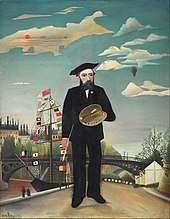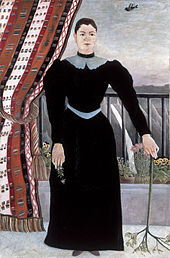Henri Rousseau

Henri Julien Félix Rousseau , called "Le Douanier Rousseau" (The customs officer Rousseau) (* May 21, 1844 in Laval , † September 2, 1910 in Paris ) was a self-taught French painter whose style is assigned to post-impressionism and naive art . He is considered to be one of the pioneers of surrealism .
Life

Henri Rousseau was born the son of a master plumber and ironmonger Julien Rousseau and his wife Eleonore. He began to be interested in poetry and music early on. After finishing school he served as a clarinetist in an infantry regiment . After his military service, he managed to get employed by customs. Hence its name Le Douanier ("the customs officer").

In 1869 he married the 18-year-old tailor Clémence Boitard, with whom he had nine children. Of these, only daughter Julia survived the father. Rousseau's granddaughter Jeanne was later a piano teacher in Cherbourg . After the death of his wife Clémence in 1888, Rousseau took early retirement in 1893. He had already started painting before that.
The first to realize the importance of his paintings was the young Alfred Jarry . Through him he got to know Paul Gauguin . In Gauguin's studio he met Mallarmé , Strindberg and Degas . Soon he was exhibiting himself in the Salon des Indépendants .
The friendship with Guillaume Apollinaire was important , through whom he was able to establish relationships with the artistic avant-garde . Rousseau meanwhile gave violin lessons to supplement his meager pension. He met Delaunay , Pablo Picasso , Braque , Max Jacob , Vlaminck , Brâncuși , Marie Laurencin , Philippe Soupault and others.
Occasionally Rousseau came into conflict with the law. When the judge sentenced him to two years' imprisonment for fraudulent checks, but suspended her on probation , he promised the judge to portray his wife.
Henri Rousseau died on September 2, 1910 in the Necker Hospital in Paris after blood poisoning . Seven people were present at his funeral: Robert Delaunay and his wife Sonja Terk , the painters Paul Signac and Julio Ortiz de Zárate , the Romanian sculptor Brâncuși, Rousseau's landlord Armand Queval and the writer Guillaume Apollinaire.
Apollinaire wrote the epitaph , the lines of which Constantin Brâncuși carved into the tombstone:
Kind Rousseau, you hear us.
We greet you,
Delaunay, his wife, Monsieur Queval and me.
Let our suitcases duty-free through the gate of heaven,
We bring you brushes, paints and canvas,
So that you can paint in the sacred leisure of true light
As once my portrait:
The face of the stars
plant
With Rousseau, reality is not portrayed, it is rather a dream. The individual elements of his pictures are idealized and yet simplified. They appear unconnected and surprisingly side by side. The background is just as sharp and clearly drawn as the foreground. The figures appear from the front or in strict profile. Rousseau loved clear contours, hard contrasts without transitions. He used bright contact colors without shadows, but his palette was rich in color nuances . In his picture The Dream (the Yadwiga) the jungle shimmers in more than fifty shades of green.
Finally, another aspect of Rousseau's coloring was important for both the modern and the surrealist painting of a Magritte or Tanguy : the economical, considered, almost anonymous application of paint, which carefully concealed the brush marks and did not reveal any handwriting. Any vanity of making was alien to Rousseau. It was not about the production of painterly textures, but about his objects.
reception



Apollinaire called Henri Rousseau the " Uccello of our century". He saw in him the primitive of a new age (who, by the way, had also claimed to be Cézanne ), in whose pictures with their poetic ciphers much of what modern art - like her - seemed naive and at the same time anticipated with great clarity unfolded around Apollinaire - was charged with performing. For the same reason he fascinated Kandinsky . His essay "On the question of form" in the "Almanach of the Blue Rider " from 1912, illustrated with no fewer than seven reproductions based on pictures by Rousseau, contains the often accepted distinction of the "embodiment forms torn from the storerooms of matter by the spirit" towards two poles, of great abstraction and great realism. “These two poles open up two paths that ultimately lead to one goal.” While Kandinsky felt called to take the first path, he saw Rousseau as his counterpart on the path of the new great realism, both revolutionaries at the beginning of each new path.
In Rousseau, Tristan Tzara paid homage to an artist who not only founded a new style of painting, but also his own lifestyle. The unity of art and life lived by the unswerving and unswerving Rousseau in his naivety had to impress the so little naive Dadaist .
The surrealist André Breton summed up, "with Rousseau we could speak of ' magical realism ' for the first time ".
Philippe Soupault wrote a monograph on Rousseau in 1927 in which he lovingly tells of his experiences with the Douanier.
Lise and Oto Bihalji-Merin write about him: “From the perspective of his worldly inept poverty, Rousseau projected childlike waking dreams full of beauty and fame. He felt his dream world so vividly and intensely that in the twilight of confidence and foreboding he exceeded the limits of the real and was convinced himself that the President of the Republic had invited him to a soirée, but that the rough porter had rejected him because of his poor clothes . ”And Apollinaire:“ Few painters were mocked as mocked as the customs officer during their lifetime, and few people faced the mockery, the rudeness with which one showered him with calmer foreheads. ”
Otto Pankok created the painting Henri Rousseau, painter and tax collector. In the background, hanging on the wall, two small and one large-format Rousseau works are duplicated.
Exhibitions (selection)
- 1911: Wilhelm Uhde , a German art dealer living in Paris, organized a commemorative exhibition in the Salon des Indépendants one year after Rousseau's death. He also published the artist's first biography.
- Herwarth Walden presented 20 paintings at the First German Autumn Salon in Berlin in 1913 - not for sale, mainly from the possession of Robert Delaunay .
- documenta 1 1955: Works of naive painting were included in the exhibition concept of documenta 1 1955 in Kassel , so that pictures by Henri Rousseau (as well as Louis Vivin and Séraphine Louis ) were also shown there.
- Henri Rousseau. Fondation Beyeler in Riehen , February 7th - May 9th 2010.
- Le Douanier Rousseau. Doge's Palace in Venice , March 6th - September 6th 2015.
- The shadow of the avant-garde. Rousseau and the forgotten masters. Museum Folkwang in Essen, curators : Kasper König and Falk Wolf, October 2, 2015 - January 10, 2016.
- Le Douanier Rousseau. L'innocence archaïque. ( Henri "Le Douanier" Rousseau. The archaic innocence. ) Musée d'Orsay , March 22nd - July 17th, 2016. Catalog.
- Douanier Rousseau: Painter's Paradise Lost. (Douanier Rousseau: The Painter's Paradise Lost.) National Gallery Prague , September 15, 2016 - January 15, 2017.
literature
- chronological -
- Wilhelm Uhde : Henri Rousseau. Rudolf Kaemmerer, Berlin 1923.
- Henri Perruchot: Henri Rousseau. A biography. Bechtle, Esslingen 1959.
- Werner Helwig : The secrets of a customs officer. Henri Rousseau. Mohn, Gütersloh 1962.
- Jean Bouret: Henri Rousseau. Bruckmann, Munich 1963.
- Dora Vallier : The Complete Works of Rousseau. Art Circle, Lucerne 1969.
- Lise and Oto Bihalji-Merin : Life and Work of the Painter Henri Rousseau. Verlag der Kunst, Dresden 1971.
- Henri Rousseau: The Present and the Past. Poems and paintings. Brandstätter, Vienna 1986, ISBN 3-85447-207-2 .
- Cornelia Stabenow: Rousseau , TASCHEN, Cologne, 1991/2018, ISBN 978-3-8365-4597-6
- Werner Schmalenbach : Henri Rousseau. Dream about the jungle. Prestel, Munich 1998, ISBN 3-7913-1951-5 .
- Emil Schwarz: Art is the art of decision. Homage to Henri Rousseau. A poetic adjustment with the essay Der Garten der Sehnsucht . NAP Verlag, Zurich 2010, ISBN 978-3-9523615-3-5 .
Movie
- The painter Henri Rousseau or The Birth of Modernism. (OT: Le douanier Rousseau, ou l'éclosion modern. ) Documentary, France, 2015, 52:26 min., Script and director: Nicolas Autheman, production: arte France, Les Films du Tambour de Soie, Musée d'Orsay, First broadcast: April 3, 2016 by arte, table of contents by arte. Documentation on the occasion of a Rousseau exhibition in the Musée d'Orsay from March 22 to July 17, 2016.
Web links
- Literature by and about Henri Rousseau in the catalog of the German National Library
- Works by Henri Rousseau at Zeno.org .
- Materials by and about Henri Rousseau in the documenta archive
- Henri Rousseau on kunstaspekte.de
Individual evidence
- ^ Lise and Oto Bihalji-Merin , Life and Work of the Painter Henri Rousseau , Verlag der Kunst , Dresden 1971.
- ↑ As a frontispiece in Lise and Oto Bihalji-Merin (1971) reproduced in b / w, note “war loss”. The picture is thought to be lost and it has not yet been datable.
- ^ Exhibition: Henri Rousseau. In: Fondation Beyeler , (German), accessed on April 4, 2016.
- ^ Exhibition: Le Douanier Rousseau. In: Musée d'Orsay , (German), accessed April 4, 2016.
- ^ Exhibition: The shadow of the avant-garde. Rousseau and the forgotten masters. In: Museum Folkwang , accessed April 4, 2016.
- ^ Exhibition: Henri "Le Douanier" Rousseau. The archaic innocence. ( Memento from April 4, 2016 in the Internet Archive ) In: Musée d'Orsay , (German), accessed on April 4, 2016.
- ↑ Liquid Design sro: Národní galerie v Praze. Retrieved January 23, 2018 .
| personal data | |
|---|---|
| SURNAME | Rousseau, Henri |
| ALTERNATIVE NAMES | Rousseau, Henri Julien Félix (full name) |
| BRIEF DESCRIPTION | French painter |
| DATE OF BIRTH | May 21, 1844 |
| PLACE OF BIRTH | Laval (Mayenne) |
| DATE OF DEATH | September 2, 1910 |
| Place of death | Paris |
